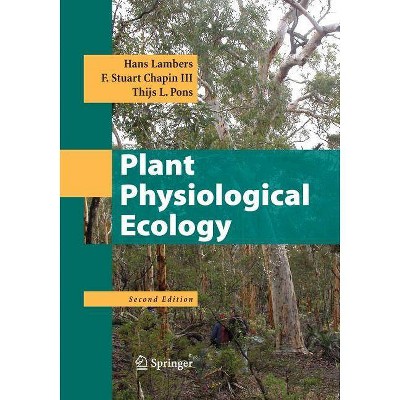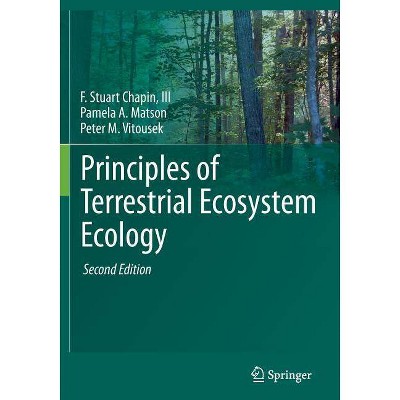Plant Physiological Ecology - 2nd Edition by Hans Lambers & F Stuart Chapin III & Thijs L Pons (Paperback)

Similar Products
Products of same category from the store
AllProduct info
<p/><br></br><p><b> Book Synopsis </b></p></br></br>Box 9E. 1 Continued FIGURE 2. The C-S-R triangle model (Grime 1979). The strategies at the three corners are C, competiti- winning species; S, stress-tolerating s- cies; R, ruderalspecies. Particular species can engage in any mixture of these three primary strategies, and the m- ture is described by their position within the triangle. comment briefly on some other dimensions that Grime's (1977) triangle (Fig. 2) (see also Sects. 6. 1 are not yet so well understood. and 6. 3 of Chapter 7 on growth and allocation) is a two-dimensional scheme. A C--S axis (Com- tition-winning species to Stress-tolerating spe- Leaf Economics Spectrum cies) reflects adaptation to favorable vs. unfavorable sites for plant growth, and an R- Five traits that are coordinated across species are axis (Ruderal species) reflects adaptation to leaf mass per area (LMA), leaf life-span, leaf N disturbance. concentration, and potential photosynthesis and dark respiration on a mass basis. In the five-trait Trait-Dimensions space,79%ofallvariation worldwideliesalonga single main axis (Fig. 33 of Chapter 2A on photo- A recent trend in plant strategy thinking has synthesis; Wright et al. 2004). Species with low been trait-dimensions, that is, spectra of varia- LMA tend to have short leaf life-spans, high leaf tion with respect to measurable traits. Compared nutrient concentrations, and high potential rates of mass-based photosynthesis. These species with category schemes, such as Raunkiaer's, trait occur at the ''quick-return'' end of the leaf e- dimensions have the merit of capturing cont- nomics spectrum.<p/><br></br><p><b> From the Back Cover </b></p></br></br><p>The growth, reproduction, and geographical distribution of plants are profoundly influenced by their physiological ecology: the interaction with the surrounding physical, chemical, and biological environments. This textbook describes mechanisms that underlie plant physiological ecology at the levels of physiology, biochemistry, biophysics, and molecular biology. At the same time, the integrative power of physiological ecology is well suited to assess the costs, benefits, and consequences of modifying plants for human needs and to evaluate the role of plants in ecosystems.</p> <p></p> <p><em>Plant Physiological Ecology, Second Edition</em> is significantly updated, with full color illustrations and begins with the primary processes of carbon metabolism and transport, plant water relations, and energy balance. After considering individual leaves and whole plants, these physiological processes are then scaled up to the level of the canopy. Subsequent chapters discuss mineral nutrition and the ways in which plants cope with nutrient-deficient or toxic soils. The book then looks at patterns of growth and allocation, life-history traits, and interactions between plants and other organisms. Later chapters deal with traits that affect decomposition of plant material and with the consequences of plant physiological ecology at ecosystem and global levels.</p> <p></p> <p><em>Plant Physiological Ecology, Second Edition</em> features numerous boxed entries that extend the discussions of selected issues, a glossary, and numerous references to the primary and review literature. This significant new text is suitable for use in plant ecology courses, as well as classes ranging from plant physiology to plant molecular biology. </p> <p><em>From reviews of the first edition: </em></p> <p><em>"</em>. . . the authors cover a wide range of plant physiological aspects which up to now could not be found in one book. . . . The book can be recommended not only to students but also to scientists working in general plant physiology and ecology as well as in applied agriculture and forestry." - <em>Journal of Plant Physiology</em></p> <p>"This is a remarkable book, which should do much to consolidate the importance of plant physiological ecology as a strongly emerging discipline. The range and depth of the book should also persuade any remaining skeptics that plant physiological ecology can offer much in helping us to understand how plants function in a changing and complex environment." - <em>Forestry</em></p> <p>"This book must be regarded as the most integrated, informative and accessible account of the complexities of plant physiological ecology. It can be highly recommended to graduate students and researchers working in all fields of plant ecology." - <em>Plant Science</em></p> <p>". . . there is a wealth of information and new ideas here, and I strongly recommend that this book be on every plant ecophysiologist's shelf. It certainly represents scholarship of the highest level, and many of us will find it a useful source of new ideas for future research." - <em>Ecology</em></p><p/><br></br><p><b> About the Author </b></p></br></br><p><strong>Hans Lambers</strong> is Professor of Plant Ecology and Head of School of Plant Biology, Faculty of Natural and Agricultural Sciences at the University of Western Australia. <strong>F. Stuart Chapin III </strong>is Professor of Ecology at the Institute of Arctic Biology, University of Alaska Fairbanks. <strong>Thijs L. Pons</strong> recently retired as Senior Lecturer in Plant Ecophysiology at the Institute of Environmental Biology, Utrecht University. </p>
Price History
Price Archive shows prices from various stores, lets you see history and find the cheapest. There is no actual sale on the website. For all support, inquiry and suggestion messagescommunication@pricearchive.us




















